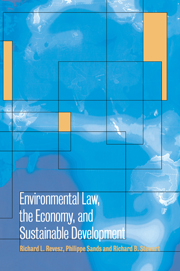 Environmental Law, the Economy and Sustainable Development
Environmental Law, the Economy and Sustainable Development Book contents
- Frontmatter
- Contents
- List of contributors
- Introduction: environmental regulation in multi-jurisdictional regimes
- PART I ENVIRONMENTAL REGULATION IN FEDERAL SYSTEMS
- PART II ENVIRONMENTAL REGULATION AND INTERNATIONAL TRADE
- PART III CHOICE OF ENVIRONMENTAL POLICY INSTRUMENTS
- PART IV THE ENVIRONMENTAL STANDARD - SETTING PROCESS
- 10 Institutions for regulating risk
- 11 Science and international environmental policy: the Intergovernmental Panel on Climate Change
- PART V INTERNATIONAL ENVIRONMENTAL LAW AND SUSTAINABLE DEVELOPMENT
- Index
10 - Institutions for regulating risk
Published online by Cambridge University Press: 03 May 2010
- Frontmatter
- Contents
- List of contributors
- Introduction: environmental regulation in multi-jurisdictional regimes
- PART I ENVIRONMENTAL REGULATION IN FEDERAL SYSTEMS
- PART II ENVIRONMENTAL REGULATION AND INTERNATIONAL TRADE
- PART III CHOICE OF ENVIRONMENTAL POLICY INSTRUMENTS
- PART IV THE ENVIRONMENTAL STANDARD - SETTING PROCESS
- 10 Institutions for regulating risk
- 11 Science and international environmental policy: the Intergovernmental Panel on Climate Change
- PART V INTERNATIONAL ENVIRONMENTAL LAW AND SUSTAINABLE DEVELOPMENT
- Index
Summary
This chapter examines three types of models for centralized risk regulation at different stages of their development: the first mature (the US model), the second maturing (the EU model), and the last in the early stages of centralization (the GATT/WTO and NAFTA models). The study focuses on questions of institutional design. It draws upon the discussion of environmental, health, and safety risk regulation in the United States presented in Breaking the Vicious Circle, a book by Stephen Breyer, co-author of this chapter. The chapter reiterates the book's central, apparently paradoxical thesis, as developed in the US institutional context: that one can more rationally deal with problems of risk regulation – including serious problems of overregulation – by granting more, not less, discretionary power to an administrative bureaucracy. It then asks those willing to accept this thesis (even if they do so only hypothetically) to consider its applicability and ramifications in other, non-US institutional settings. To this end, the chapter first examines its potential consequences for the European Union. Is it desirable to give EU administrators more authority and discretion in the risk regulatory process? Is it politically feasible to do so? What might the result be? We hope that this essay, though it rests in substantial part upon American experience, will stimulate thought on these questions in Europe. Continuing, the chapter addresses these issues in the context of multilateral agreements – in particular international trade agreements such as GATT/WTO and NAFTA – and international dispute resolution mechanisms and their impact on the development and implementation of risk regulation policies.
- Type
- Chapter
- Information
- Environmental Law, the Economy and Sustainable DevelopmentThe United States, the European Union and the International Community, pp. 283 - 352Publisher: Cambridge University PressPrint publication year: 2000
- 3
- Cited by


